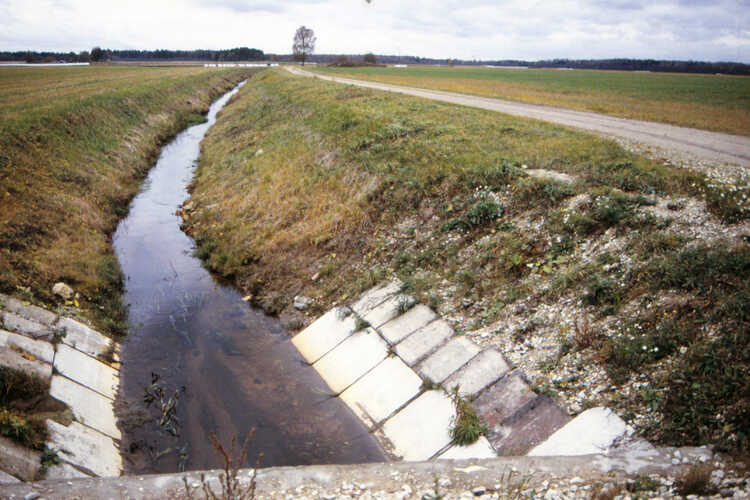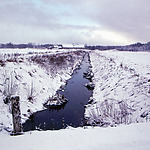In 1998 it was also decided that during two years, parallel to the current project, experience would also be gained with land consolidation in two areas. This project was financed by the Netherlands Ministry of Economic Affairs and carried out by the consulting firm Euroconsult, together with the Netherlands Government Agency for Land and Water Use. They had asked me whether I would continue my role for the next two years, but then for both projects combined, on the same basis. Since I found these projects pleasant and interesting, I again said yes.
In the context of the second project component, a meeting of the local Land Consolidation Committee was organised in Tartu. There appeared to be a great deal of agreement on the approach, both among the Estonians and with the Dutch project staff. However, opinions differed on one point. It concerned the duration of each step. The Estonians wanted to complete everything much faster than the Dutch considered possible. I carefully explained that things do indeed generally go a bit faster here than we are used to in the Netherlands. I am curious whether they will make it happen, but I have a lot of confidence in this.
We will also visit the University of Tartu again. During my previous visits, I became quite desperate because each time I got an explanation why they could not get it done. It was about simulating the effect of drainage on groundwater movement and thus on crop yields using a computer model. I then gave a passionate speech as to why I thought they should do everything they could to finally get it done. To my surprise, this turned out to have helped. They showed me a report with exactly the alternatives and variants that I considered of importance. I am very happy with this, and my Estonian counterpart is also happy, because this gives him the tools to urge his minister to continue with the project. They also explained to us that the results are very preliminary because everything still needs to be verified. We wished them the best of luck with this. Based on the available results, we already knew enough because the trends that could reasonably be expected were shown very clearly.
The next day back to the Ministry of Agriculture. It is suddenly quite busy, because the Dutch project staff has grown to four people. They are busy discussing how they will present the project during the steering group meeting the next day. I spend the whole day chatting, collecting data and typing. Because they are able to deliver all the necessary data very quickly, I make good progress with my report. I really cannot get some data the same day, I get them the next day. They apologize for this. Beautiful country.
At the insistence of the Dutch project staff, it was decided to conduct the steering group meeting on location in one of the two project areas. The steering group members can then also see where they are talking about by means of a field visit. I had already been to that area twice, but was indeed the only steering group member with this experience.
In the regional office of the Rural Development Division of the Ministry of Agriculture we have our steering group meeting. After a few explanatory stories we discuss the project plan and approve it after some discussion. We go on a field visit and slide over the slippery semi-paved roads. A representative of the Netherlands Embassy is also among us. During this kind of field visits I always feel a bit sorry for embassy people, who always try very hard to keep up under these kinds of ‘muddy’ circumstances, but clearly show that they are absolutely not used to it. The Estonians are well aware of this and the course contains many holes with splashing water. Always good to emphasise the need for support for rural development. It delivers the desired result. People find it a very interesting field visit. We have lunch in a local inn and after a few more short explanations we return to Tallinn.
I was in Estonia for the seventh time. It became routine. Two more times the following year and then this project is over for me. I was curious about what awaited me this time. In the end, it went very differently than I had expected. Shortly after I reported to the Ministry of Agriculture on Tuesday morning, it became clear to me that they wanted to apply for a second loan from the World Bank, something that had not been the intention until then. This changed my mission from more or less routine discussions and reporting on the progress of the projects, into a mission in which the principles of the next loan had to be pre-cooked. In itself, I was happy with this, because in this way there was continuity in the projects, something I had already insisted on in my previous missions.
The program also changed completely. Instead of staying in Tallinn more or less the whole week, we went on a two-day field visit to look at a number of things that they wanted my opinion on. Anyway, first Tuesday the whole day in Tallinn for all kinds of talks and collecting the necessary data. In the framework of the current project, the drainage and water discharge systems in some 75,000 hectares, divided over some 70 areas of about 1,000 hectares each, had been renovated, the farmers in these areas had to form Water Users Associations, pay for 20% of the renovation and then do the annual maintenance themselves.
On Wednesday we left for Tartu with a large group. We were going to first look at one of the two land consolidation projects and then have a steering group meeting. It turned out that in the meantime the drainage in this area had been improved and that there was agreement on the land consolidation plan. Formally, there was still two weeks for any objections, but no one expected these to come. They were going to start improving the roads immediately after that, which could still be done just before the winter. The rest of the work would follow in the spring. In total, the land consolidation in this area would take more than two years. Unthinkably fast under Dutch conditions, but half a year too long by Estonian standards. I insisted that we should not rush into the next projects, because this could be detrimental to the farmers' involvement. The rest of the week I worked with my Estonian counterpart on the necessary details of the proposal for the follow-up project in order to properly approach the possible second loan from the World Bank.
The next day we first had a look at the Rannu project. This area had been renovated in 1996 and all the ditches appeared to be neatly maintained again. There was a problem with a large culvert. During a large discharge in the spring, the lining after the outlet had been washed away and was now about five meters away. I insist that they repair it before the winter, because otherwise the matter could erode considerably next spring. They look a bit dubious, because they have no money. When I tell them that it will be twice as expensive if they do not do it before the winter, they become a bit more understanding and they will see that they will find a solution. The nice thing in Estonia is that then they actually do it.
We also visit two polder areas. Here there are problems with the water quality, with the maintenance of the watercourses and in the second polder also with the discharge and pollution from a landfill. Most of the problems are not that big in my opinion and we discuss the various possible solutions while hanging over the car. A separate problem is the drainage in the second polder. Here the farmers do not want to pay for the drainage and the ministry itself no longer has the money to do this. In the meantime the drainage has been stopped for two years and the low parts are now under water. It is a sad sight. They ask what to do. I suggest that they do nothing for now. Under the climatological conditions in Estonia the water level in the polder will rise by an average of about 10 cm per year. It seems to me that in the long term it will be necessary to talk to the farmers. I wonder if this will work.
I pay my last visit to the head of the Land Registry to say goodbye. He tells me that 67% of the land has now been returned and that the rest is nature reserve and forest. So they have actually completed it. I compliment him on this. He says: “Yes, and the French started under Napoleon and they are not ready.” We say goodbye laughing.
Saturday evening the new representative of the World Bank arrives in Tallinn. With the Estonian project supervisor on behalf of the World Bank in Tallinn and two other employees we will go out for dinner somewhere. During dinner we will go through the necessary issues. The new representative of the World Bank would like to see one of the renovated areas, in order to get an impression for himself of what it is actually about. We will visit one of the two land consolidation areas. In the area we will look at a number of ditches that have been renovated and an improved road. On the GIS maps that were made by the Estonian consultant the old and the new parcelization can be seen very clearly, as well as the changes of ownership. We check this in a few places.
When the man from the World Bank wants to talk with a farmer, we find one a little further on. The farmer in question turns out to be a member of the Land Consolidation Committee and he enthusiastically tells us how he thinks the conditions will improve. It couldn't be better and the man from the World Bank is clearly impressed. We go to a restaurant and after some preliminary skirmishes an agreement is reached in principle on the proposed second loan from the World Bank. It will probably take another year before they really agree on the loan, but by including a number of items under the current loan the project can continue more or less undisturbed. Isn't it nice that a week in Estonia can make a small contribution to a project of about four years. With a good feeling I finish my mission report on Sunday evening and deliver it to the porter of the Ministry of Agriculture. My activities in Estonia are over.
In 2019, my wife and I went on holiday to Latvia and Estonia. Both countries, as well as Lithuania, are now members of the European Union, have joined Schengen and also use the Euro as currency. Both in the cities and in the countryside, it is clear that they have not been sitting still and, despite the necessary problems, have made good progress since independence. It is nice to see this progress.

